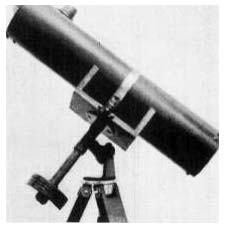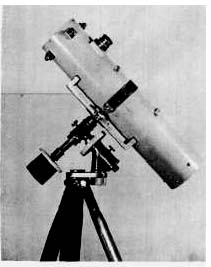Often, before his first telescope finished, the enthusiastic amateur is planning on a second one. This is the usual manifestation of a healthy interest in an exacting and fascinating hobby, but it should be subjected to a modicum of restraint. The tyro should be wary of any impulse to make a telescope of great aperture and focal length, and should carefully consider the practicability of such a project, and the probability of its successful conclusion. He must also consider the ways, if any, in which a second instrument can supplement the observing program planned for the first telescope.
Pyrex mirror blanks are cast in stock sizes of 4¼”, 6″, 8″, 10″, 12½”, and 16″, providing a range of apertures calculated to satisfy the most intrepid individual. But large mirrors (10-inch and more) must be figured to a most rigorous tolerance; also, the larger the mirror, the greater the volume of atmosphere with which it must cope. The mounting parts may assume formidable proportions, and require an extensive amount of machining. Comparative costs of telescopes of different sizes have been estimated to vary with the cube of the aperture, although many amateurs have ingeniously solved the mechanical problems and materially reduced the expense by the adaptation of secondhand automobile parts for mountings. And in order to observe comfortably while standing on the ground (the height of one’s neighbors should also be considered), the height of the eyepiece position should not in general exceed about 60″ when the telescope is pointing to the zenith. This places a practical limitation on the focal length of the mirror, unless at times one is prepared to put up with the inconveniences of a portable platform or a stepladder.
If the demands on one’s optical skill are not to be too severe, the telescope is pretty well restricted, in the 4¼-inch size, to ratios above f/6, and in the 6- and 8-inch to ratios of f/6 to f/8. These proportions permit slight departures of the figure from a paraboloid, without material impairment of the definition. The beginner can also choose from these sizes, if for some reason he does not elect to make the 6-inch f/8.
In lesser ratios in the above diameters, and in all ratios in the large sizes, any measurable departure of the figure from a paraboloid cannot be considered, as the allowable tolerance in knife-edge movement will then be exceeded by the error of the testing observation.
Long-focus Telescopes
If you wonder why the 6-inch f/9 and f/10 are omitted from the list of “easy” mirrors, it should be stated that unless one has already made a pretty fair mirror, and has become very familiar with the parabolizing stroke and the shadow appearances, he will in all likelihood not succeed with an f/9 or f/10. It has often been said that an f/10 can be finished with a spherical figure, but the spherical aberration from such a mirror seriously impairs fine contrasts. Only a casual worker will be content with inferior performance.
Figuring these nearly spherical mirrors is quite difficult. Under test, the paraboloidal shadows appear so faint and delicate that to the uninitiated eye they practically defy analysis. Figured to a stage where the boundaries between light and shadow become clearly definable, it is a certainty that there will be strong overcorrection. In parabolizing a shallow mirror, best done on a hard lap, there is no time for experimentation with the stroke, so quickly is the figure altered. The proper stroke must be known and used at the start, and this knowledge can be gained only through previous practice. But the patient and able worker is amply rewarded in the exquisite definition to be had from these mirrors of longer focus.
By the simple expedient of hurdling the f/10, however, and making a 6-inch mirror of ratio f/12 or more, the amateur avoids the necessity of parabolizing, and can finish the surface with a spherical figure. He will achieve the most perfect long-focus reflector performance that it is possible to obtain, and have a telescope particularly suited for lunar and planetary observations.
Since the f/10 and higher-ratio instruments are primarily intended to be used with high magnification, their diagonals need be only sufficiently large to provide full illumination over the field of a ½” eyepiece. This calls for a width of about 1″ in the case of the 6-inch f/10 mirror, and ¾” for the f/12. The diffraction effects from such proportionately small diagonals should he quite invisible. It may prove difficult, however, for the amateur to construct a supporting mechanism that will not extend beyond the boundaries of a diagonal of such small size. It might be more practical, rather than using the hinge and spring of Fig. 59, to make provision for the angular adjustment by slotting the holes in the telescope tube where the spider is anchored. Then, by attaching the diagonal rigidly to its support, at as near a 45° angle as possible, any discrepancy can be corrected by tilting the entire spider in the slots. In this method, the position of the spider should also be changed from the one shown in Fig. 63, the vanes being placed in vertical and horizontal planes (with respect to that diagram). Only those holes lying in the vertical plane, or in the plane of the eyepiece, need be slotted.
The longer tube makes the mounting more sensitive to vibrations from air movements; therefore, if a pipe mounting as described in Chapter 14 is going to be constructed, the type shown in Fig. 73 should be the choice.
Short-focus Telescopes
An ideal companion telescope for a 6-inch f/12 is a 6-inch f/4 which, equipped with a low-power eyepiece, will embrace a field of view slightly less than 2½ in diameter. This rich-field telescope {RFT) furnishes beautiful views of rich star fields, clusters, and nebulae. With it, the Andromeda galaxy can be seen extending over the entire width of the field; it is also possible to distinguish the North America nebula in Cygnus. Thus armed with two instruments of equal light grasp, and a possible range in powers from 21x to 240x or more, the amateur is well equipped for a most varied program of astronomical study.
In the discussion of exit pupil in Chapter 13, it was shown that the least magnification which should be used on a telescope is one that yields an exit pupil of about 7 mm., found to accompany a magnification of about 3½ per inch of aperture. This corresponds to a power of 21 for a 6-inch telescope of 24″ focal length, and in turn requires a focal length of 1 1/7″ in the eyepiece. That is a rather odd focal length, not ordinarily obtainable; therefore, the focal length of the mirror should be so adjusted that its combination with a good low-power eyepiece of whatever focal length can be had will furnish a 7-mm. exit pupil. If you propose to use a 1″ eyepiece, then the focal length of the mirror should be 21″, but this combination will result in less than a 2° field. Moreover, because of increasing aberrations and the difficulty of figuring, it is not advisable to go below f/4. A superior combination, embracing a field of about 2°, is an eyepiece of 1½” focal length and a mirror of ratio about f/5. A Kellner eyepiece of about 1¼” focal length, with a 50° apparent field, should not be too difficult to obtain, and used with a mirror of about 26″ focal length, it will probably give most satisfactory results.
We have intimated that a low-ratio mirror must be very precisely figured, and this is true if it is to perform within the Rayleigh limit or even within twice that limit. But in the size, and for the wide-angle observing of which we are speaking, there is no necessity for correcting the mirror to those exacting tolerances. Primarily, a wide field of view, some 2° or more in diameter, is what is sought, and even a perfect paraboloid of the proportions given cannot combine all of the rays to meet within a half wave for a star more than a few seconds of arc from the mirror’s axis.
And with the low powers that will be used, the observer can hardly become aware of any deficiency that may exist near the center of the field. But no leniency can be extended to the diagonal, which must be flat in any case. A poor diagonal will do more injury to the images than will a poor mirror.
For all deep mirrors (small focal ratio), the pitch lap should be somewhat on the soft side, as considerable flow is demanded in following the deepening curve of the mirror as its figure approaches the paraboloid. And here one must have the patience to carry on the figuring strokes for comparatively long intervals, in order to give the lap a chance to function. A deep mirror does not necessarily have to be brought to a spherical figure before commencing the parabolizing. This practice is pursued for the shallower mirrors because the sphere provides a fix, to borrow a navigator’s term, close to the final destination, and in the short remaining run one is not expected to stray far from the course. But with an f/4 or f/5, so much work remains to be done that it is probably a waste of time to struggle for the sphere, and the parabolizing strokes, described in Chapter 7, should be adopted as soon as the polishing shows signs of completion.

On a deep mirror, there is ample time to discover any existing zonal discrepancies by means of the knife-edge test, and to correct them by experiment with the strokes. A reasonably good figure should be present on the mirror when it is judged to be completed. Perhaps, after using the telescope for a time, and enjoying the benefits of his labors, the amateur will decide to refigure the mirror as close to perfection as possible, and then try to determine if any improvement in its performance is discernible.
A low-ratio mirror is very sensitive to misalignment; the slightest error will produce an annoying flare on a star image. Therefore, the utmost care should be taken in the construction of the cell and other parts. For improved accuracy, try 1/16″ instead of l/8″ holes in the cardboard disks used in aligning. For a 6-inch f/4, the offsetting of the center of plate E, Fig. 59, ought not to be ignored, as in this case it amounts to about six per cent of the minor axis of the diagonal. With this offset, you may find it somewhat disconcerting when reflections cannot be brought concentric as you peer through the adapter tube while attempting to adjust the angle of deflection. This condition can be partly overcome by making the diameter of the diagonal larger by the amount necessary to effect centralization in the tube, but as it already obstructs a considerable percentage of the light, any further increase should be avoided. Therefore, a disk of blackened cardboard of the larger diameter required can be temporarily placed on the end of the rod H, Fig. 59, and discarded after the adjustments have been completed. On out-of-focus star images, of course, the shadow of the diagonal will not De quite concentric with the diffraction rings, but as long as the visible rings are round, and each one evenly bright, the adjustments must be in order.
The f/4 can, if necessary, be more lightly mounted than the f/8 or f/10, due to its much shorter tube and the lower magnifications that will be used with it. Fittings one size smaller than those listed under “A,” Table I, will be satisfactory; for instance, the axes may be of ¾” pipe, and the tees 1″ pipe size. Also, because of the shorter tube, the mounting can be attached directly to the tripod head, dispensing with the pillar. (See Fig. 93A )
|
|
